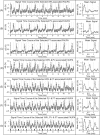Greater brain activity during the resting state and the control of activation during the performance of tasks
- PMID: 30903028
- PMCID: PMC6430806
- DOI: 10.1038/s41598-019-41606-2
Greater brain activity during the resting state and the control of activation during the performance of tasks
Abstract
The brain's operations are mainly intrinsic, involving the acquisition and maintenance of information for interpreting, responding to and predicting environmental demands. The brain's on-going intrinsic activity (i.e., the resting-state activity) is spontaneous, but this spontaneous activity exhibits a surprising level of spatial and temporal organization across the whole brain. In this study we compared the intrinsic activity with the activity evoked by tasks, and made the comparison at several levels of analysis from a finger-tapping-activated area within the primary sensorimotor cortex to the whole brain. We found that, contrary to our intuition, the intrinsic activity was substantially larger than the task activity and consistently so for all levels of analysis. For the task state, the brain: (1) controlled the intrinsic activity not only during the performance of a task but also during the rest between tasks; (2) activated a task-specific network only when the task was performed but kept it relatively "silent" for other different tasks; and (3) simultaneously controlled the activation of all task-specific networks during the performance of each task.
Conflict of interest statement
The author declares no competing interests.
Figures







References
Publication types
MeSH terms
LinkOut - more resources
Full Text Sources

